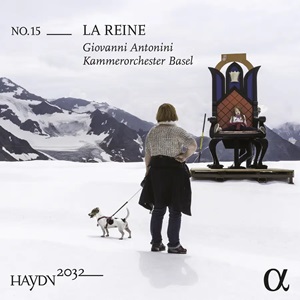
Joseph Haydn (1732-1809)
Symphony No 85 in B-flat major, Hob. I:85, “La Reine”
Symphony No 62 in D major, Hob. I:62
Symphony No 50 in C major, Hob. I:50
Basel Chamber Orchestra/Giovanni Antonini
rec. 2021, Don Bosco, Basel, Switzerland
Haydn 2032, Vol 15
Alpha Classics 696 [66]
Giovanni Antonini’s Haydn Symphony cycle continues its steady progress, and has now reached Volume 15. The project aims to reach its conclusion in 2032, the year of the composer’s tercentenary. In common with the previous releases, each volume centres around a theme; this one is titled “La Reine” after the Symphony No 85, which bears that title. Many of the previous volumes have included a work by one of the composer’s contemporaries, but not this one. The performances are played on period instruments, and two ensembles share the task over the series, namely Il Giardino Armonico and the Basle Chamber Orchestra. This present offering features the latter.
As the album’s title “La Reine” suggests, the theme running through the programme is one of regality. Centre stage is the Symphony No 85 in B-flat major, “La Reine“, undoubtedly the best known of the three symphonies featured here. Dating from around 1785, it is the fourth of the composer’s six “Paris Symphonies”, commissioned by the Concert de la Loge Olympique. Its title or nickname came into being early on as the work was a favourite of Marie Antoinette, Queen of France from 1774. The two other symphonies on the disc are No 50, a slightly earlier work. It’s thought that the first two movements were reconstructed from a marionette opera by Haydn called Der Gotterath (Prologue to Philemon und Baucis), now lost. It was performed for the Empress Maria Theresa in 1773. No 62 from 1780 celebrates the fortieth anniversary of Maria Theresa’s accession to the throne.
Antonini adopts lively tempi in the outer movements of the symphonies. Articulation is crisp, there’s plenty of bite and control of dynamics is masterful. The whole effect is thrilling, and the music is truly brought to life. Nos 85 and 50 open with majestic Adagio introductions. The slow movements are elegant and richly warm. No 85’s is a theme and variations, described by H C Robbins Landon as “a set of variations on the old French folk-song “La gentille et jeune Lisette”. It contains some beautifully contoured woodwind passages. The Allegretto of No 62 is delicate and ethereal, and the diaphanous strings sound muted to me. It precedes a rather lusty and buoyant Menuet. The finale is unusual in that the spirited Allegro is ushered in by a couple bars of mysterious string melody. The Adagio opening of No 50 sounds quite staid and unimpressive, but once the Allegro di molto enters, the music comes to life with vim and vigour. The strings sound quite athletic. After two fairly uninspired central movements, the work ends with a punchy and vigorous finale.
Characteristically with this series, production values remain high. Antonini has worked very closely with musicologist Christian Moritz-Bauer throughout this endeavour, and both have contributed to the booklet notes. The disc comes housed in an attractive gatefold. As with the previous volumes, the performances have been warmly recorded, and the balance between the instruments couldn’t be bettered. Orchestral detail has been captured to marvellous effect.
Stephen Greenbank
Buying this recording via a link below generates revenue for MWI and helps us keep free access to the site




















